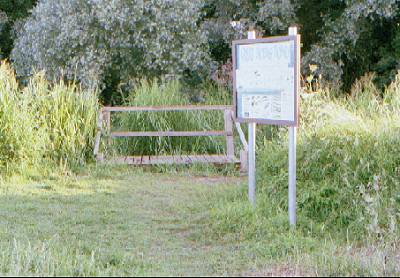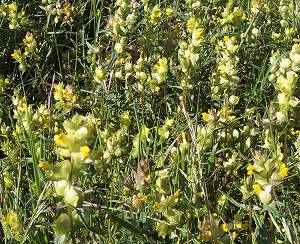Great Salterns
Lying South of Burrfields Road in Portsmouth, Great Salterns Reserve is managed by Portsmouth City Council.
It is about seven hectares of open grassland and scrub. Grid reference :
SU668022.
A rather thin clay cap means that the soil is generally poor in nutrients. Most
of the large blocks of hawthorn and blackthorn were planted, along with a small
copse of poplar near the old farm buildings. Large areas of the reserve remain
as rank but open grassland, which is good for some species of butterflies, such
as Meadow Brown and Gatekeeper.
Not far from Great Salterns is Milton Common, which has a greater variety of
vegetation. This may partly be due to the larger size of the Common, and also
because a considerable amount of chalk from Portsdown Hill was used to
construct the sea wall and some access routes at Milton Common.
The reserve and land to the south form a Site of Importance for Nature
Conservation (SINC) covering 20 hectares. Some delapidated out-buildings from
Great Salterns Farm remain standing, though the farm-house has long gone.
 A variety of birds including Kestrel,
Whitethroat, Blackcap and Skylark can be seen.
A variety of birds including Kestrel,
Whitethroat, Blackcap and Skylark can be seen.
The hedge along Burrfields Road was planted by volunteers in 1994 and 1995, and
is now doing well, except for a bit at the western end where the bindweed rules
supreme. In true conservation fashion, what is wanted in one place isn't
usually wanted somewhere else, so work continues on cutting bays into some of
the scrub in order to increase its age structure and provide a greater variety
of habitats. The Bee Orchid is often the first of the orchid family to appear
on disturbed or re-made ground. In summer 2002, one was found on a patch of
land just to the east of the official reserve boundary.
Great Salterns Preservation Society
The Great Salterns Preservation Society (GSPS) takes an active interest in the
reserve and all the open land to the south down to Stanley Avenue. Some of the
bramble bushes are full of vigour, and would make the paths impassable if not
regularly cut back. Trees have been planted and maintained. Near the old farm
buildings is a pond which has had a chequered history of being filled in and
re-dug. It was stocked with plants by local Trust volunteers, and the GSPS have
helped by removing excess growth. They have also installed a viewing platform
and information board next to the pond, with notes on their work and the
wildlife in the area. Paths in the area have been given a hard surface of
hoggin by the GSPS and teams from Community Service Volunteers.
 Some areas of rough grassland have been cut and sown with seeds of Yellow Rattle. This plant
is semi-parasitic on grass and will help to reduce its growth, and lead to a
greater diversity of species.
Some areas of rough grassland have been cut and sown with seeds of Yellow Rattle. This plant
is semi-parasitic on grass and will help to reduce its growth, and lead to a
greater diversity of species.
The society has a morning work party on the second Sunday of each month,
starting at 1030 am. They meet at the entrance to Great Salterns near the car
park for the Archery Club, at the northern end of Westover Road.
The Past
The Great Salterns area was formerly called Gatcombe Haven. It was 1200 acres
of multi-fingered creeks, connecting to Langstone Harbour by a narrow entrance.
In 1640 the Crown gave a lease to Dr. William Quatremaine to reclaim the Haven
from the harbour by building a sea-wall. Keeping the sea out proved to be an
expensive business, so Quatremaine teamed up with Richard Alchorne. On 25th
July 1664 the pair were granted a new lease for 300 acres, for 99 years at 4d
an acre, in order to establish salterns (lagoons for evaporating sea-water to
produce salt). Alchorne was also involved in running the Great Salterns Farm.
There may well have been small-scale salterns in the harbour from Roman times,
but the Royal Navy was now a major customer, requiring enough salt to preserve
the meat from about 5000 cattle per year. Salt was produced by evaporating
sea-water during the summer, in a series of three ponds, then boiling the brine
in vats. The industry lasted until about 1800, when it encountered a
double-whammy of taxation and serious competition from mined salt. The street
names of Quatremaine Road and Alchorne Place now provide a link to the
past.
In 1830 the Crown sold what was now called the Great Salterns Estate, and it
was used for agriculture. The Estate was bought by Portsmouth Corporation in
about 1920, and was used to provide the golf course, allotments, playing fields
and grazing. Great Salterns Lake, now an integral feature and obstacle of the
golf course, is the southern end of the old Gatcombe Haven. Things started to
go downhill in the 1930s when the area of the present reserve was used to dump
household waste, a process only completed thirty years later. Anti-aircraft
batteries were set up during WWII, and there are thought to be two or three
unexploded bombs somewhere in the ground. For more historical details see :
Great Salterns 1600-1983 A brief history, by J. Ainsworth (Portsmouth Records
Office)
The Spirit of Portsmouth - A History, by Webb, Quail, Haskell and Riley (In
Print)
Back to Sites
 A variety of birds including Kestrel,
Whitethroat, Blackcap and Skylark can be seen.
A variety of birds including Kestrel,
Whitethroat, Blackcap and Skylark can be seen. Some areas of rough grassland have been cut and sown with seeds of Yellow Rattle. This plant
is semi-parasitic on grass and will help to reduce its growth, and lead to a
greater diversity of species.
Some areas of rough grassland have been cut and sown with seeds of Yellow Rattle. This plant
is semi-parasitic on grass and will help to reduce its growth, and lead to a
greater diversity of species.